Cross-Cultural Capability: Risk, Opportunities for Spring Line Limited
VerifiedAdded on 2022/12/14
|9
|3233
|154
Report
AI Summary
This report delves into the concept of cross-cultural capability and its significance within organizations, particularly in the context of globalization and international business expansion. Using Spring Line Limited as a case study, the report analyzes the cultural differences between Europe and China, highlighting disparities in working hours, management styles, and motivational tools. It identifies the risks and opportunities faced by HR departments when expanding into the Chinese market, including language barriers, cultural misunderstandings, complex policies, hiring challenges, and differing HRM practices. The report also explores the application of Hofstede's model to determine cultural differences between Europe and China, offering insights into how these differences impact business operations. The findings underscore the need for businesses to develop cross-cultural competence to navigate challenges and capitalize on opportunities in the global marketplace.
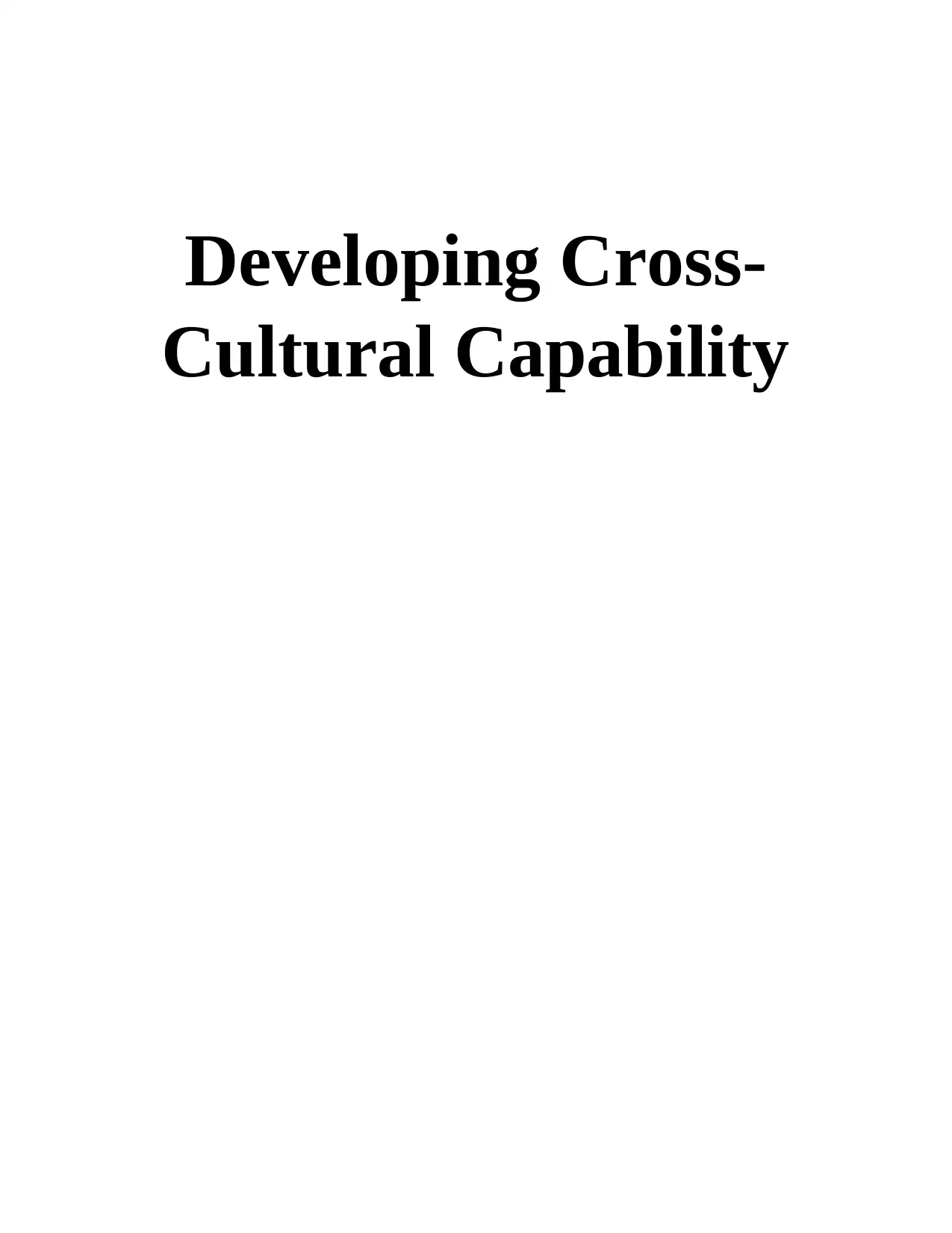
Developing Cross-
Cultural Capability
Cultural Capability
Paraphrase This Document
Need a fresh take? Get an instant paraphrase of this document with our AI Paraphraser

Contents
INTRODUCTION ...........................................................................................................................................3
MAIN BODY .................................................................................................................................................3
TASK.............................................................................................................................................................3
Difference between Europe and China ...................................................................................................3
Risk and opportunities faced by selected company at the time of expanding their business in China. . .4
Application of Hofstede model to determine cultural differences between Europe and China..............7
CONCLUSION...............................................................................................................................................8
REFERENCES ................................................................................................................................................9
INTRODUCTION ...........................................................................................................................................3
MAIN BODY .................................................................................................................................................3
TASK.............................................................................................................................................................3
Difference between Europe and China ...................................................................................................3
Risk and opportunities faced by selected company at the time of expanding their business in China. . .4
Application of Hofstede model to determine cultural differences between Europe and China..............7
CONCLUSION...............................................................................................................................................8
REFERENCES ................................................................................................................................................9
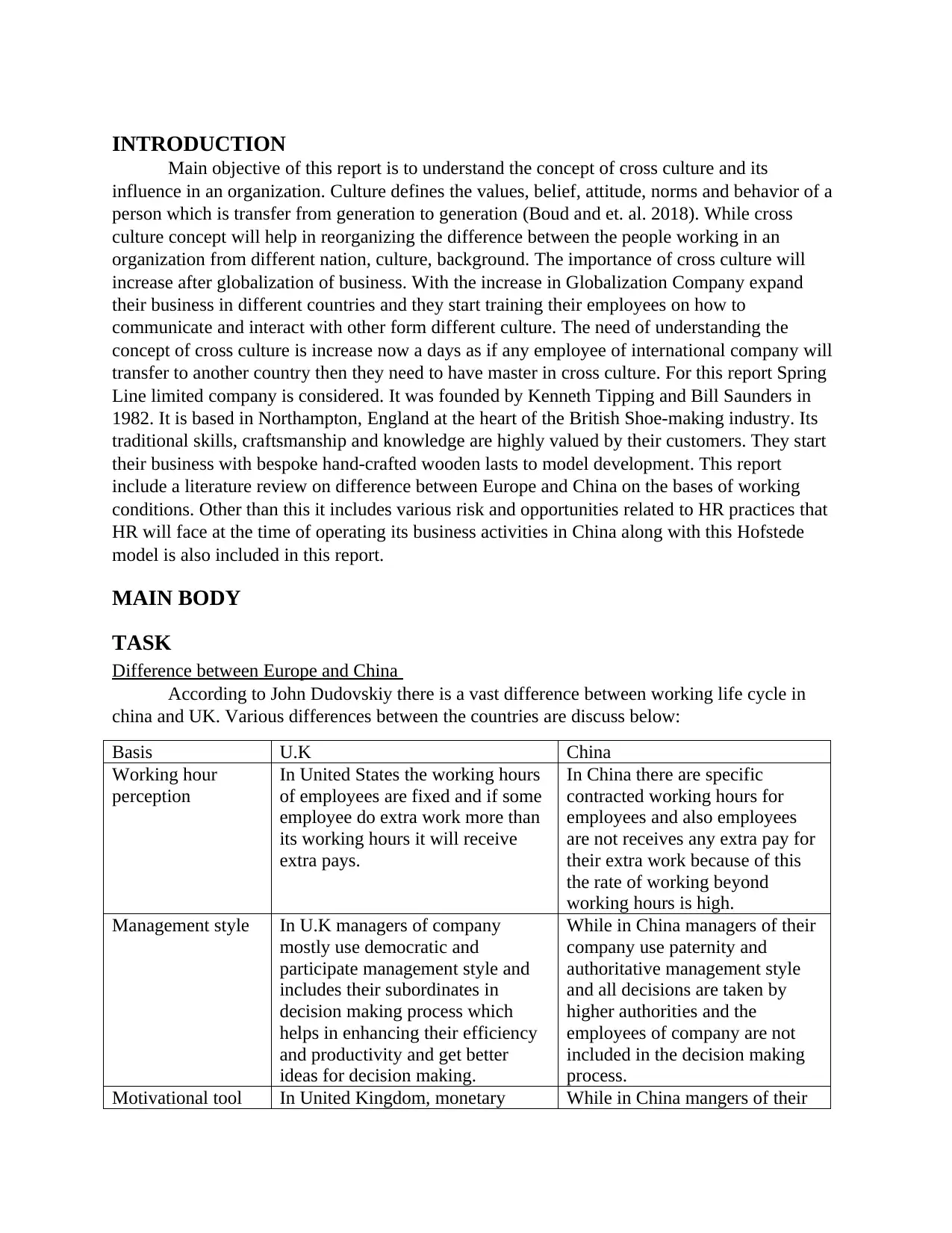
INTRODUCTION
Main objective of this report is to understand the concept of cross culture and its
influence in an organization. Culture defines the values, belief, attitude, norms and behavior of a
person which is transfer from generation to generation (Boud and et. al. 2018). While cross
culture concept will help in reorganizing the difference between the people working in an
organization from different nation, culture, background. The importance of cross culture will
increase after globalization of business. With the increase in Globalization Company expand
their business in different countries and they start training their employees on how to
communicate and interact with other form different culture. The need of understanding the
concept of cross culture is increase now a days as if any employee of international company will
transfer to another country then they need to have master in cross culture. For this report Spring
Line limited company is considered. It was founded by Kenneth Tipping and Bill Saunders in
1982. It is based in Northampton, England at the heart of the British Shoe-making industry. Its
traditional skills, craftsmanship and knowledge are highly valued by their customers. They start
their business with bespoke hand-crafted wooden lasts to model development. This report
include a literature review on difference between Europe and China on the bases of working
conditions. Other than this it includes various risk and opportunities related to HR practices that
HR will face at the time of operating its business activities in China along with this Hofstede
model is also included in this report.
MAIN BODY
TASK
Difference between Europe and China
According to John Dudovskiy there is a vast difference between working life cycle in
china and UK. Various differences between the countries are discuss below:
Basis U.K China
Working hour
perception
In United States the working hours
of employees are fixed and if some
employee do extra work more than
its working hours it will receive
extra pays.
In China there are specific
contracted working hours for
employees and also employees
are not receives any extra pay for
their extra work because of this
the rate of working beyond
working hours is high.
Management style In U.K managers of company
mostly use democratic and
participate management style and
includes their subordinates in
decision making process which
helps in enhancing their efficiency
and productivity and get better
ideas for decision making.
While in China managers of their
company use paternity and
authoritative management style
and all decisions are taken by
higher authorities and the
employees of company are not
included in the decision making
process.
Motivational tool In United Kingdom, monetary While in China mangers of their
Main objective of this report is to understand the concept of cross culture and its
influence in an organization. Culture defines the values, belief, attitude, norms and behavior of a
person which is transfer from generation to generation (Boud and et. al. 2018). While cross
culture concept will help in reorganizing the difference between the people working in an
organization from different nation, culture, background. The importance of cross culture will
increase after globalization of business. With the increase in Globalization Company expand
their business in different countries and they start training their employees on how to
communicate and interact with other form different culture. The need of understanding the
concept of cross culture is increase now a days as if any employee of international company will
transfer to another country then they need to have master in cross culture. For this report Spring
Line limited company is considered. It was founded by Kenneth Tipping and Bill Saunders in
1982. It is based in Northampton, England at the heart of the British Shoe-making industry. Its
traditional skills, craftsmanship and knowledge are highly valued by their customers. They start
their business with bespoke hand-crafted wooden lasts to model development. This report
include a literature review on difference between Europe and China on the bases of working
conditions. Other than this it includes various risk and opportunities related to HR practices that
HR will face at the time of operating its business activities in China along with this Hofstede
model is also included in this report.
MAIN BODY
TASK
Difference between Europe and China
According to John Dudovskiy there is a vast difference between working life cycle in
china and UK. Various differences between the countries are discuss below:
Basis U.K China
Working hour
perception
In United States the working hours
of employees are fixed and if some
employee do extra work more than
its working hours it will receive
extra pays.
In China there are specific
contracted working hours for
employees and also employees
are not receives any extra pay for
their extra work because of this
the rate of working beyond
working hours is high.
Management style In U.K managers of company
mostly use democratic and
participate management style and
includes their subordinates in
decision making process which
helps in enhancing their efficiency
and productivity and get better
ideas for decision making.
While in China managers of their
company use paternity and
authoritative management style
and all decisions are taken by
higher authorities and the
employees of company are not
included in the decision making
process.
Motivational tool In United Kingdom, monetary While in China mangers of their
⊘ This is a preview!⊘
Do you want full access?
Subscribe today to unlock all pages.

Trusted by 1+ million students worldwide
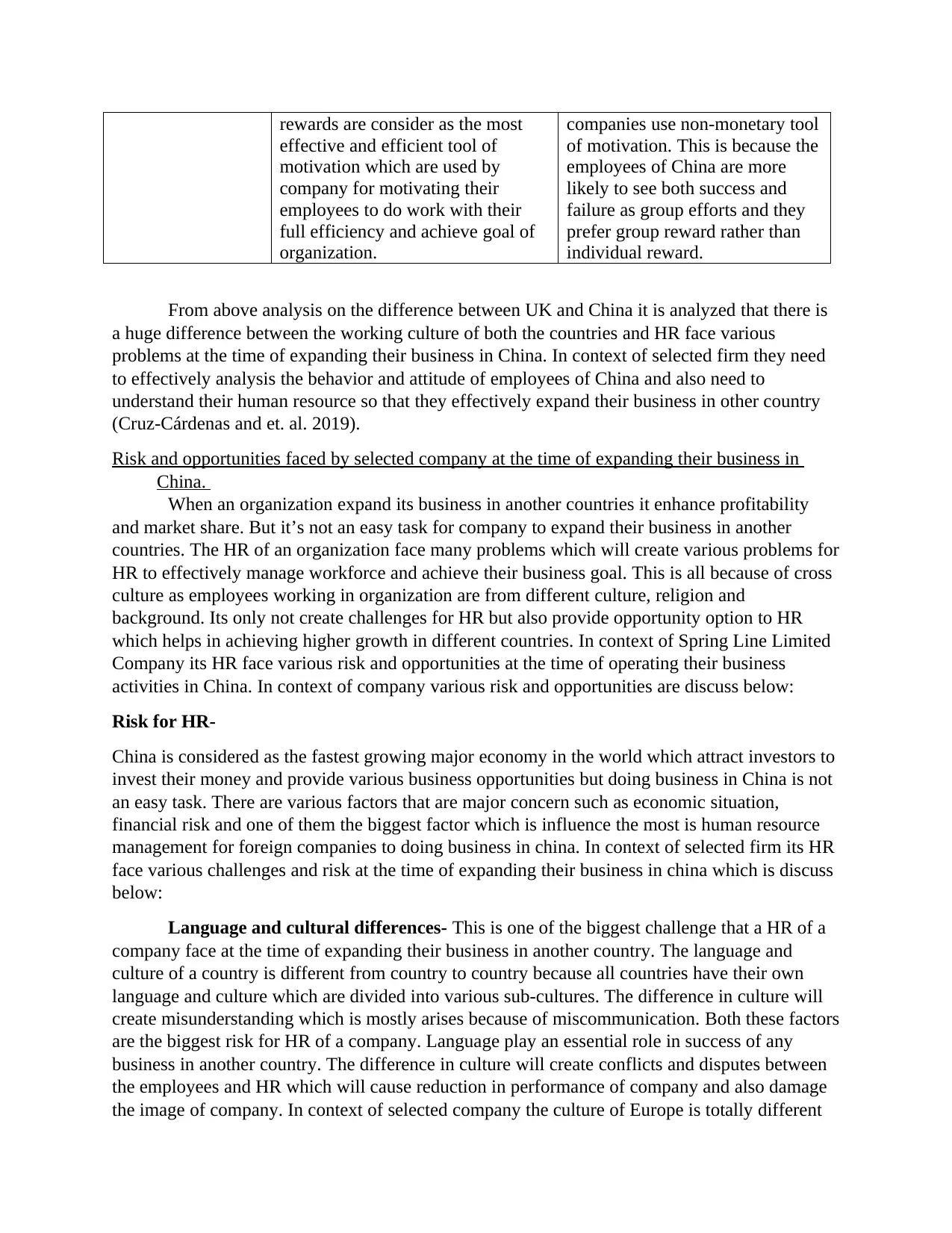
rewards are consider as the most
effective and efficient tool of
motivation which are used by
company for motivating their
employees to do work with their
full efficiency and achieve goal of
organization.
companies use non-monetary tool
of motivation. This is because the
employees of China are more
likely to see both success and
failure as group efforts and they
prefer group reward rather than
individual reward.
From above analysis on the difference between UK and China it is analyzed that there is
a huge difference between the working culture of both the countries and HR face various
problems at the time of expanding their business in China. In context of selected firm they need
to effectively analysis the behavior and attitude of employees of China and also need to
understand their human resource so that they effectively expand their business in other country
(Cruz-Cárdenas and et. al. 2019).
Risk and opportunities faced by selected company at the time of expanding their business in
China.
When an organization expand its business in another countries it enhance profitability
and market share. But it’s not an easy task for company to expand their business in another
countries. The HR of an organization face many problems which will create various problems for
HR to effectively manage workforce and achieve their business goal. This is all because of cross
culture as employees working in organization are from different culture, religion and
background. Its only not create challenges for HR but also provide opportunity option to HR
which helps in achieving higher growth in different countries. In context of Spring Line Limited
Company its HR face various risk and opportunities at the time of operating their business
activities in China. In context of company various risk and opportunities are discuss below:
Risk for HR-
China is considered as the fastest growing major economy in the world which attract investors to
invest their money and provide various business opportunities but doing business in China is not
an easy task. There are various factors that are major concern such as economic situation,
financial risk and one of them the biggest factor which is influence the most is human resource
management for foreign companies to doing business in china. In context of selected firm its HR
face various challenges and risk at the time of expanding their business in china which is discuss
below:
Language and cultural differences- This is one of the biggest challenge that a HR of a
company face at the time of expanding their business in another country. The language and
culture of a country is different from country to country because all countries have their own
language and culture which are divided into various sub-cultures. The difference in culture will
create misunderstanding which is mostly arises because of miscommunication. Both these factors
are the biggest risk for HR of a company. Language play an essential role in success of any
business in another country. The difference in culture will create conflicts and disputes between
the employees and HR which will cause reduction in performance of company and also damage
the image of company. In context of selected company the culture of Europe is totally different
effective and efficient tool of
motivation which are used by
company for motivating their
employees to do work with their
full efficiency and achieve goal of
organization.
companies use non-monetary tool
of motivation. This is because the
employees of China are more
likely to see both success and
failure as group efforts and they
prefer group reward rather than
individual reward.
From above analysis on the difference between UK and China it is analyzed that there is
a huge difference between the working culture of both the countries and HR face various
problems at the time of expanding their business in China. In context of selected firm they need
to effectively analysis the behavior and attitude of employees of China and also need to
understand their human resource so that they effectively expand their business in other country
(Cruz-Cárdenas and et. al. 2019).
Risk and opportunities faced by selected company at the time of expanding their business in
China.
When an organization expand its business in another countries it enhance profitability
and market share. But it’s not an easy task for company to expand their business in another
countries. The HR of an organization face many problems which will create various problems for
HR to effectively manage workforce and achieve their business goal. This is all because of cross
culture as employees working in organization are from different culture, religion and
background. Its only not create challenges for HR but also provide opportunity option to HR
which helps in achieving higher growth in different countries. In context of Spring Line Limited
Company its HR face various risk and opportunities at the time of operating their business
activities in China. In context of company various risk and opportunities are discuss below:
Risk for HR-
China is considered as the fastest growing major economy in the world which attract investors to
invest their money and provide various business opportunities but doing business in China is not
an easy task. There are various factors that are major concern such as economic situation,
financial risk and one of them the biggest factor which is influence the most is human resource
management for foreign companies to doing business in china. In context of selected firm its HR
face various challenges and risk at the time of expanding their business in china which is discuss
below:
Language and cultural differences- This is one of the biggest challenge that a HR of a
company face at the time of expanding their business in another country. The language and
culture of a country is different from country to country because all countries have their own
language and culture which are divided into various sub-cultures. The difference in culture will
create misunderstanding which is mostly arises because of miscommunication. Both these factors
are the biggest risk for HR of a company. Language play an essential role in success of any
business in another country. The difference in culture will create conflicts and disputes between
the employees and HR which will cause reduction in performance of company and also damage
the image of company. In context of selected company the culture of Europe is totally different
Paraphrase This Document
Need a fresh take? Get an instant paraphrase of this document with our AI Paraphraser
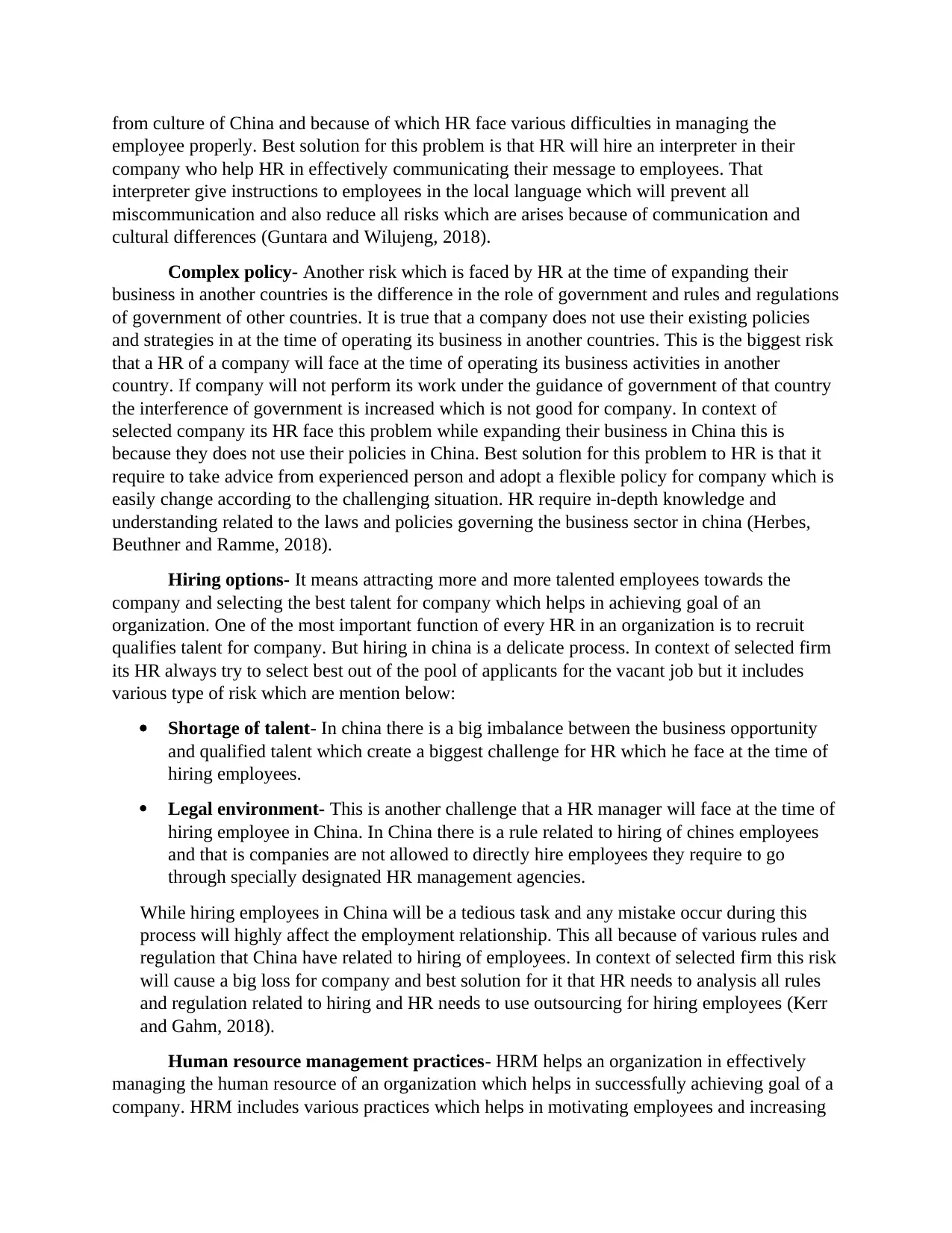
from culture of China and because of which HR face various difficulties in managing the
employee properly. Best solution for this problem is that HR will hire an interpreter in their
company who help HR in effectively communicating their message to employees. That
interpreter give instructions to employees in the local language which will prevent all
miscommunication and also reduce all risks which are arises because of communication and
cultural differences (Guntara and Wilujeng, 2018).
Complex policy- Another risk which is faced by HR at the time of expanding their
business in another countries is the difference in the role of government and rules and regulations
of government of other countries. It is true that a company does not use their existing policies
and strategies in at the time of operating its business in another countries. This is the biggest risk
that a HR of a company will face at the time of operating its business activities in another
country. If company will not perform its work under the guidance of government of that country
the interference of government is increased which is not good for company. In context of
selected company its HR face this problem while expanding their business in China this is
because they does not use their policies in China. Best solution for this problem to HR is that it
require to take advice from experienced person and adopt a flexible policy for company which is
easily change according to the challenging situation. HR require in-depth knowledge and
understanding related to the laws and policies governing the business sector in china (Herbes,
Beuthner and Ramme, 2018).
Hiring options- It means attracting more and more talented employees towards the
company and selecting the best talent for company which helps in achieving goal of an
organization. One of the most important function of every HR in an organization is to recruit
qualifies talent for company. But hiring in china is a delicate process. In context of selected firm
its HR always try to select best out of the pool of applicants for the vacant job but it includes
various type of risk which are mention below:
Shortage of talent- In china there is a big imbalance between the business opportunity
and qualified talent which create a biggest challenge for HR which he face at the time of
hiring employees.
Legal environment- This is another challenge that a HR manager will face at the time of
hiring employee in China. In China there is a rule related to hiring of chines employees
and that is companies are not allowed to directly hire employees they require to go
through specially designated HR management agencies.
While hiring employees in China will be a tedious task and any mistake occur during this
process will highly affect the employment relationship. This all because of various rules and
regulation that China have related to hiring of employees. In context of selected firm this risk
will cause a big loss for company and best solution for it that HR needs to analysis all rules
and regulation related to hiring and HR needs to use outsourcing for hiring employees (Kerr
and Gahm, 2018).
Human resource management practices- HRM helps an organization in effectively
managing the human resource of an organization which helps in successfully achieving goal of a
company. HRM includes various practices which helps in motivating employees and increasing
employee properly. Best solution for this problem is that HR will hire an interpreter in their
company who help HR in effectively communicating their message to employees. That
interpreter give instructions to employees in the local language which will prevent all
miscommunication and also reduce all risks which are arises because of communication and
cultural differences (Guntara and Wilujeng, 2018).
Complex policy- Another risk which is faced by HR at the time of expanding their
business in another countries is the difference in the role of government and rules and regulations
of government of other countries. It is true that a company does not use their existing policies
and strategies in at the time of operating its business in another countries. This is the biggest risk
that a HR of a company will face at the time of operating its business activities in another
country. If company will not perform its work under the guidance of government of that country
the interference of government is increased which is not good for company. In context of
selected company its HR face this problem while expanding their business in China this is
because they does not use their policies in China. Best solution for this problem to HR is that it
require to take advice from experienced person and adopt a flexible policy for company which is
easily change according to the challenging situation. HR require in-depth knowledge and
understanding related to the laws and policies governing the business sector in china (Herbes,
Beuthner and Ramme, 2018).
Hiring options- It means attracting more and more talented employees towards the
company and selecting the best talent for company which helps in achieving goal of an
organization. One of the most important function of every HR in an organization is to recruit
qualifies talent for company. But hiring in china is a delicate process. In context of selected firm
its HR always try to select best out of the pool of applicants for the vacant job but it includes
various type of risk which are mention below:
Shortage of talent- In china there is a big imbalance between the business opportunity
and qualified talent which create a biggest challenge for HR which he face at the time of
hiring employees.
Legal environment- This is another challenge that a HR manager will face at the time of
hiring employee in China. In China there is a rule related to hiring of chines employees
and that is companies are not allowed to directly hire employees they require to go
through specially designated HR management agencies.
While hiring employees in China will be a tedious task and any mistake occur during this
process will highly affect the employment relationship. This all because of various rules and
regulation that China have related to hiring of employees. In context of selected firm this risk
will cause a big loss for company and best solution for it that HR needs to analysis all rules
and regulation related to hiring and HR needs to use outsourcing for hiring employees (Kerr
and Gahm, 2018).
Human resource management practices- HRM helps an organization in effectively
managing the human resource of an organization which helps in successfully achieving goal of a
company. HRM includes various practices which helps in motivating employees and increasing
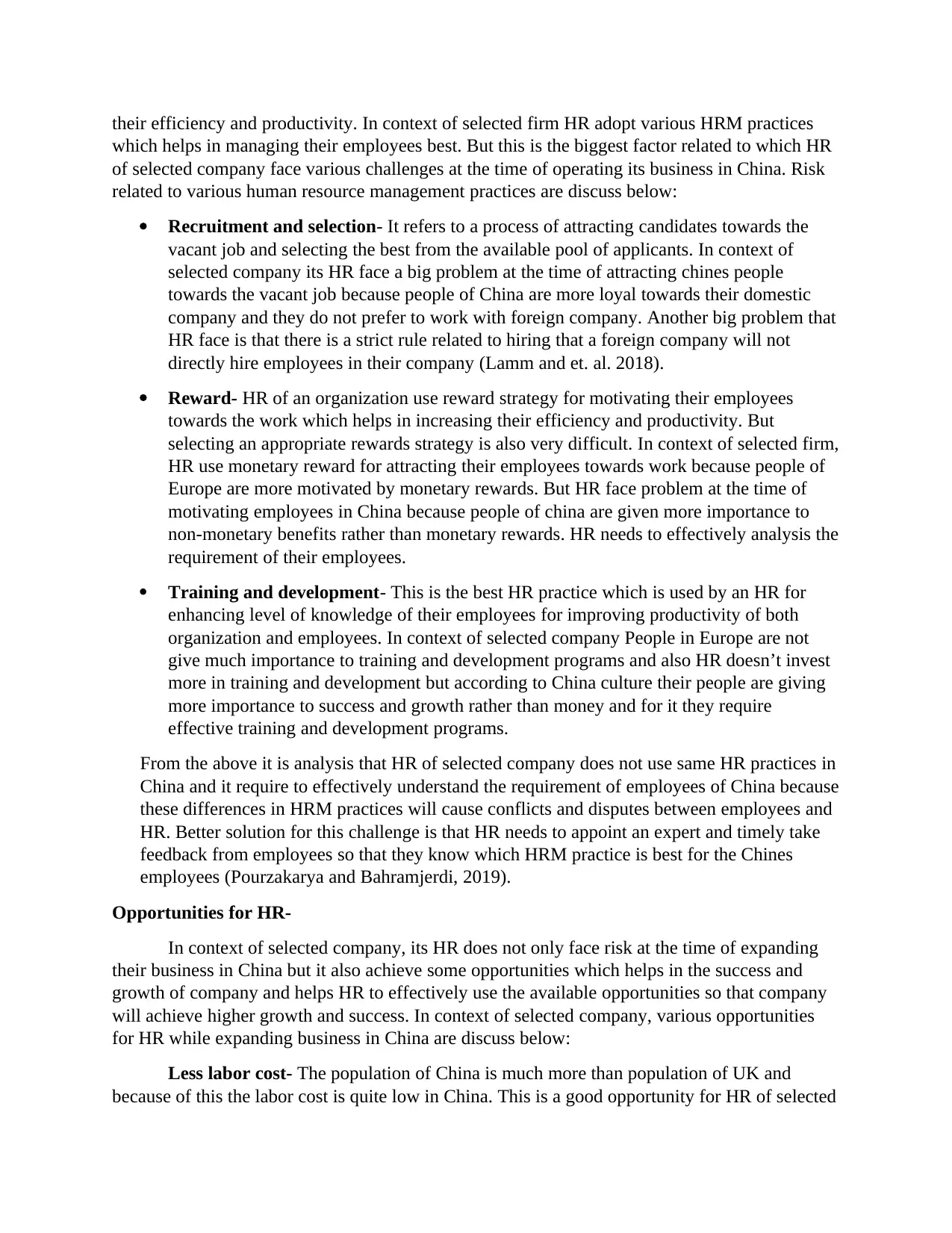
their efficiency and productivity. In context of selected firm HR adopt various HRM practices
which helps in managing their employees best. But this is the biggest factor related to which HR
of selected company face various challenges at the time of operating its business in China. Risk
related to various human resource management practices are discuss below:
Recruitment and selection- It refers to a process of attracting candidates towards the
vacant job and selecting the best from the available pool of applicants. In context of
selected company its HR face a big problem at the time of attracting chines people
towards the vacant job because people of China are more loyal towards their domestic
company and they do not prefer to work with foreign company. Another big problem that
HR face is that there is a strict rule related to hiring that a foreign company will not
directly hire employees in their company (Lamm and et. al. 2018).
Reward- HR of an organization use reward strategy for motivating their employees
towards the work which helps in increasing their efficiency and productivity. But
selecting an appropriate rewards strategy is also very difficult. In context of selected firm,
HR use monetary reward for attracting their employees towards work because people of
Europe are more motivated by monetary rewards. But HR face problem at the time of
motivating employees in China because people of china are given more importance to
non-monetary benefits rather than monetary rewards. HR needs to effectively analysis the
requirement of their employees.
Training and development- This is the best HR practice which is used by an HR for
enhancing level of knowledge of their employees for improving productivity of both
organization and employees. In context of selected company People in Europe are not
give much importance to training and development programs and also HR doesn’t invest
more in training and development but according to China culture their people are giving
more importance to success and growth rather than money and for it they require
effective training and development programs.
From the above it is analysis that HR of selected company does not use same HR practices in
China and it require to effectively understand the requirement of employees of China because
these differences in HRM practices will cause conflicts and disputes between employees and
HR. Better solution for this challenge is that HR needs to appoint an expert and timely take
feedback from employees so that they know which HRM practice is best for the Chines
employees (Pourzakarya and Bahramjerdi, 2019).
Opportunities for HR-
In context of selected company, its HR does not only face risk at the time of expanding
their business in China but it also achieve some opportunities which helps in the success and
growth of company and helps HR to effectively use the available opportunities so that company
will achieve higher growth and success. In context of selected company, various opportunities
for HR while expanding business in China are discuss below:
Less labor cost- The population of China is much more than population of UK and
because of this the labor cost is quite low in China. This is a good opportunity for HR of selected
which helps in managing their employees best. But this is the biggest factor related to which HR
of selected company face various challenges at the time of operating its business in China. Risk
related to various human resource management practices are discuss below:
Recruitment and selection- It refers to a process of attracting candidates towards the
vacant job and selecting the best from the available pool of applicants. In context of
selected company its HR face a big problem at the time of attracting chines people
towards the vacant job because people of China are more loyal towards their domestic
company and they do not prefer to work with foreign company. Another big problem that
HR face is that there is a strict rule related to hiring that a foreign company will not
directly hire employees in their company (Lamm and et. al. 2018).
Reward- HR of an organization use reward strategy for motivating their employees
towards the work which helps in increasing their efficiency and productivity. But
selecting an appropriate rewards strategy is also very difficult. In context of selected firm,
HR use monetary reward for attracting their employees towards work because people of
Europe are more motivated by monetary rewards. But HR face problem at the time of
motivating employees in China because people of china are given more importance to
non-monetary benefits rather than monetary rewards. HR needs to effectively analysis the
requirement of their employees.
Training and development- This is the best HR practice which is used by an HR for
enhancing level of knowledge of their employees for improving productivity of both
organization and employees. In context of selected company People in Europe are not
give much importance to training and development programs and also HR doesn’t invest
more in training and development but according to China culture their people are giving
more importance to success and growth rather than money and for it they require
effective training and development programs.
From the above it is analysis that HR of selected company does not use same HR practices in
China and it require to effectively understand the requirement of employees of China because
these differences in HRM practices will cause conflicts and disputes between employees and
HR. Better solution for this challenge is that HR needs to appoint an expert and timely take
feedback from employees so that they know which HRM practice is best for the Chines
employees (Pourzakarya and Bahramjerdi, 2019).
Opportunities for HR-
In context of selected company, its HR does not only face risk at the time of expanding
their business in China but it also achieve some opportunities which helps in the success and
growth of company and helps HR to effectively use the available opportunities so that company
will achieve higher growth and success. In context of selected company, various opportunities
for HR while expanding business in China are discuss below:
Less labor cost- The population of China is much more than population of UK and
because of this the labor cost is quite low in China. This is a good opportunity for HR of selected
⊘ This is a preview!⊘
Do you want full access?
Subscribe today to unlock all pages.

Trusted by 1+ million students worldwide
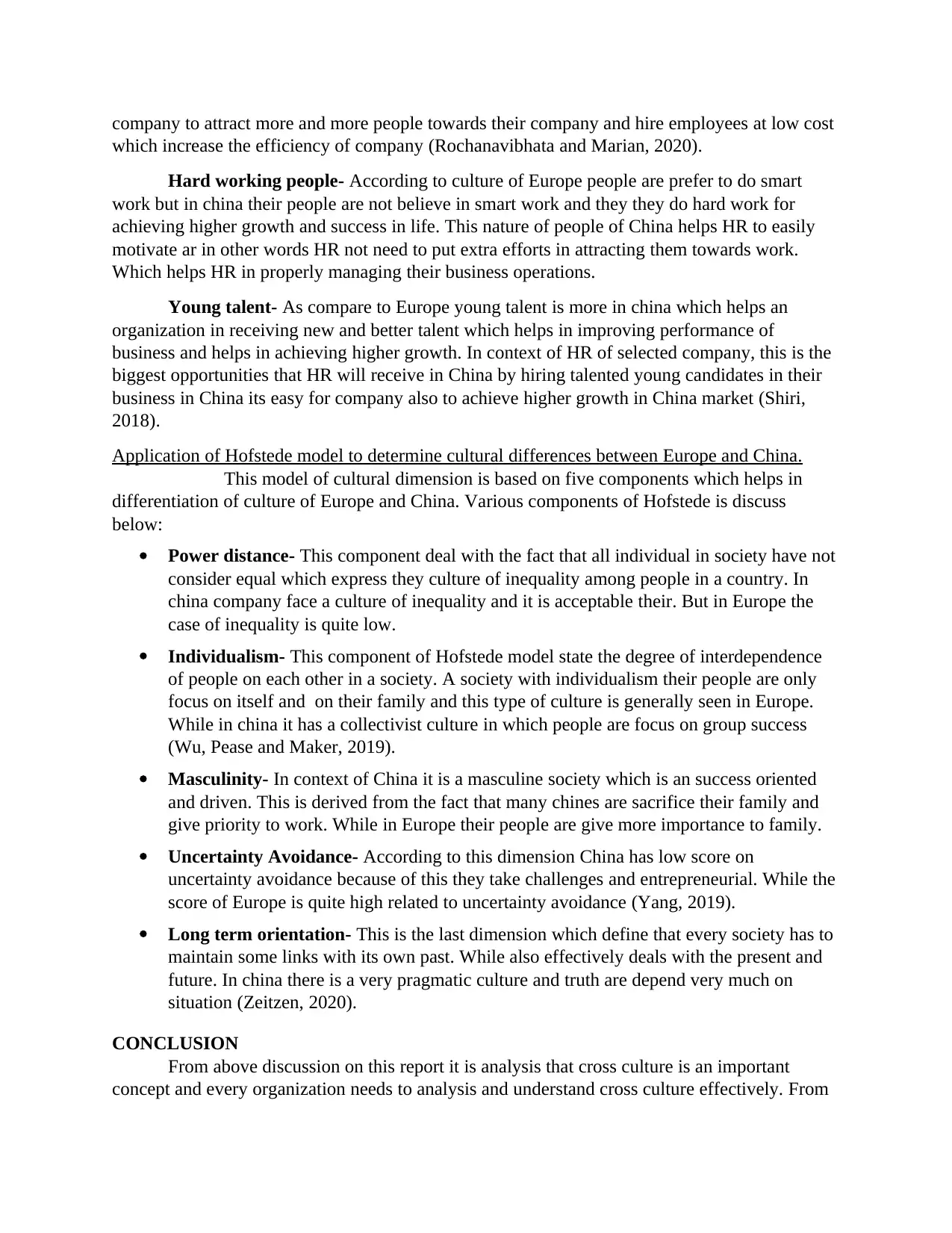
company to attract more and more people towards their company and hire employees at low cost
which increase the efficiency of company (Rochanavibhata and Marian, 2020).
Hard working people- According to culture of Europe people are prefer to do smart
work but in china their people are not believe in smart work and they they do hard work for
achieving higher growth and success in life. This nature of people of China helps HR to easily
motivate ar in other words HR not need to put extra efforts in attracting them towards work.
Which helps HR in properly managing their business operations.
Young talent- As compare to Europe young talent is more in china which helps an
organization in receiving new and better talent which helps in improving performance of
business and helps in achieving higher growth. In context of HR of selected company, this is the
biggest opportunities that HR will receive in China by hiring talented young candidates in their
business in China its easy for company also to achieve higher growth in China market (Shiri,
2018).
Application of Hofstede model to determine cultural differences between Europe and China.
This model of cultural dimension is based on five components which helps in
differentiation of culture of Europe and China. Various components of Hofstede is discuss
below:
Power distance- This component deal with the fact that all individual in society have not
consider equal which express they culture of inequality among people in a country. In
china company face a culture of inequality and it is acceptable their. But in Europe the
case of inequality is quite low.
Individualism- This component of Hofstede model state the degree of interdependence
of people on each other in a society. A society with individualism their people are only
focus on itself and on their family and this type of culture is generally seen in Europe.
While in china it has a collectivist culture in which people are focus on group success
(Wu, Pease and Maker, 2019).
Masculinity- In context of China it is a masculine society which is an success oriented
and driven. This is derived from the fact that many chines are sacrifice their family and
give priority to work. While in Europe their people are give more importance to family.
Uncertainty Avoidance- According to this dimension China has low score on
uncertainty avoidance because of this they take challenges and entrepreneurial. While the
score of Europe is quite high related to uncertainty avoidance (Yang, 2019).
Long term orientation- This is the last dimension which define that every society has to
maintain some links with its own past. While also effectively deals with the present and
future. In china there is a very pragmatic culture and truth are depend very much on
situation (Zeitzen, 2020).
CONCLUSION
From above discussion on this report it is analysis that cross culture is an important
concept and every organization needs to analysis and understand cross culture effectively. From
which increase the efficiency of company (Rochanavibhata and Marian, 2020).
Hard working people- According to culture of Europe people are prefer to do smart
work but in china their people are not believe in smart work and they they do hard work for
achieving higher growth and success in life. This nature of people of China helps HR to easily
motivate ar in other words HR not need to put extra efforts in attracting them towards work.
Which helps HR in properly managing their business operations.
Young talent- As compare to Europe young talent is more in china which helps an
organization in receiving new and better talent which helps in improving performance of
business and helps in achieving higher growth. In context of HR of selected company, this is the
biggest opportunities that HR will receive in China by hiring talented young candidates in their
business in China its easy for company also to achieve higher growth in China market (Shiri,
2018).
Application of Hofstede model to determine cultural differences between Europe and China.
This model of cultural dimension is based on five components which helps in
differentiation of culture of Europe and China. Various components of Hofstede is discuss
below:
Power distance- This component deal with the fact that all individual in society have not
consider equal which express they culture of inequality among people in a country. In
china company face a culture of inequality and it is acceptable their. But in Europe the
case of inequality is quite low.
Individualism- This component of Hofstede model state the degree of interdependence
of people on each other in a society. A society with individualism their people are only
focus on itself and on their family and this type of culture is generally seen in Europe.
While in china it has a collectivist culture in which people are focus on group success
(Wu, Pease and Maker, 2019).
Masculinity- In context of China it is a masculine society which is an success oriented
and driven. This is derived from the fact that many chines are sacrifice their family and
give priority to work. While in Europe their people are give more importance to family.
Uncertainty Avoidance- According to this dimension China has low score on
uncertainty avoidance because of this they take challenges and entrepreneurial. While the
score of Europe is quite high related to uncertainty avoidance (Yang, 2019).
Long term orientation- This is the last dimension which define that every society has to
maintain some links with its own past. While also effectively deals with the present and
future. In china there is a very pragmatic culture and truth are depend very much on
situation (Zeitzen, 2020).
CONCLUSION
From above discussion on this report it is analysis that cross culture is an important
concept and every organization needs to analysis and understand cross culture effectively. From
Paraphrase This Document
Need a fresh take? Get an instant paraphrase of this document with our AI Paraphraser
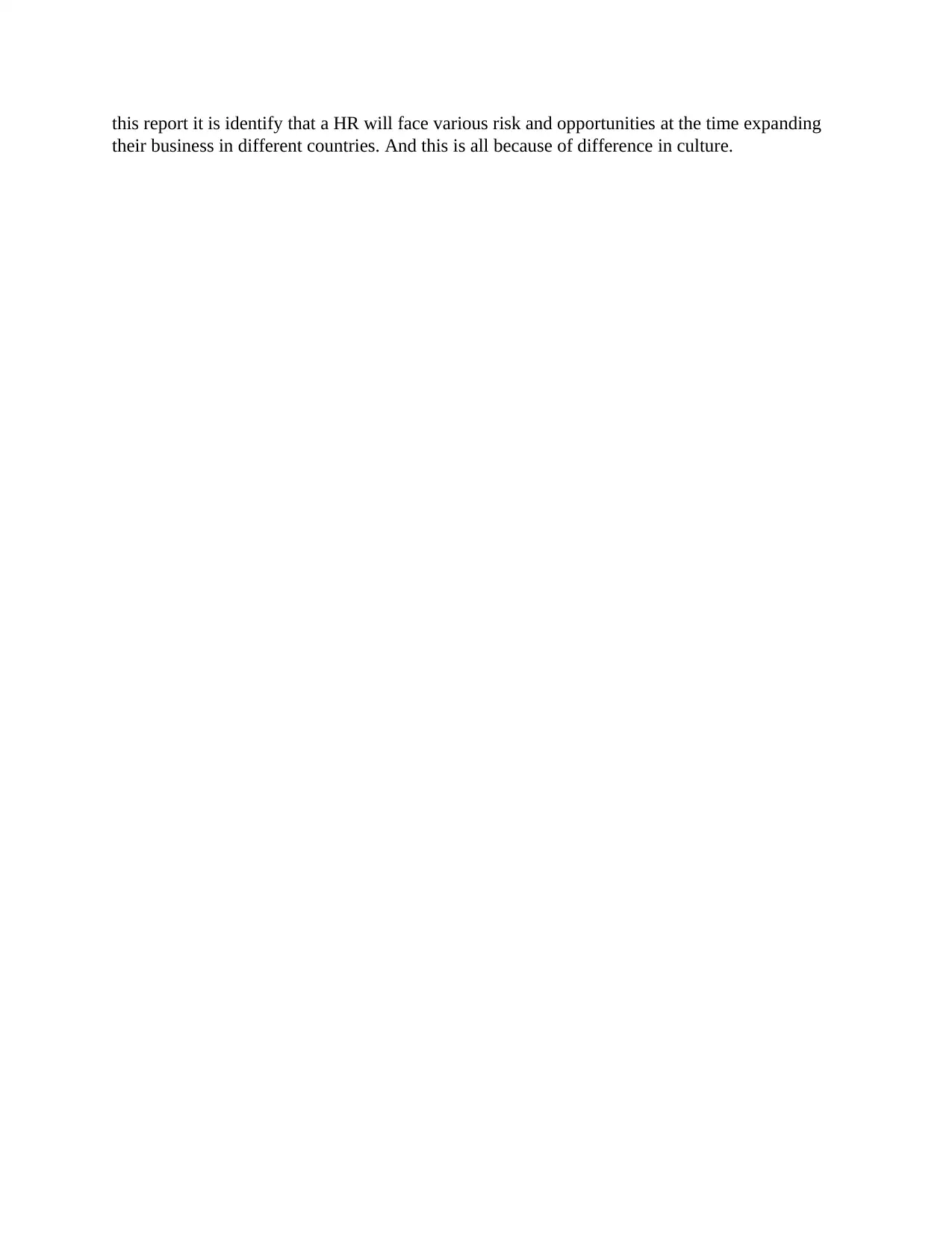
this report it is identify that a HR will face various risk and opportunities at the time expanding
their business in different countries. And this is all because of difference in culture.
their business in different countries. And this is all because of difference in culture.
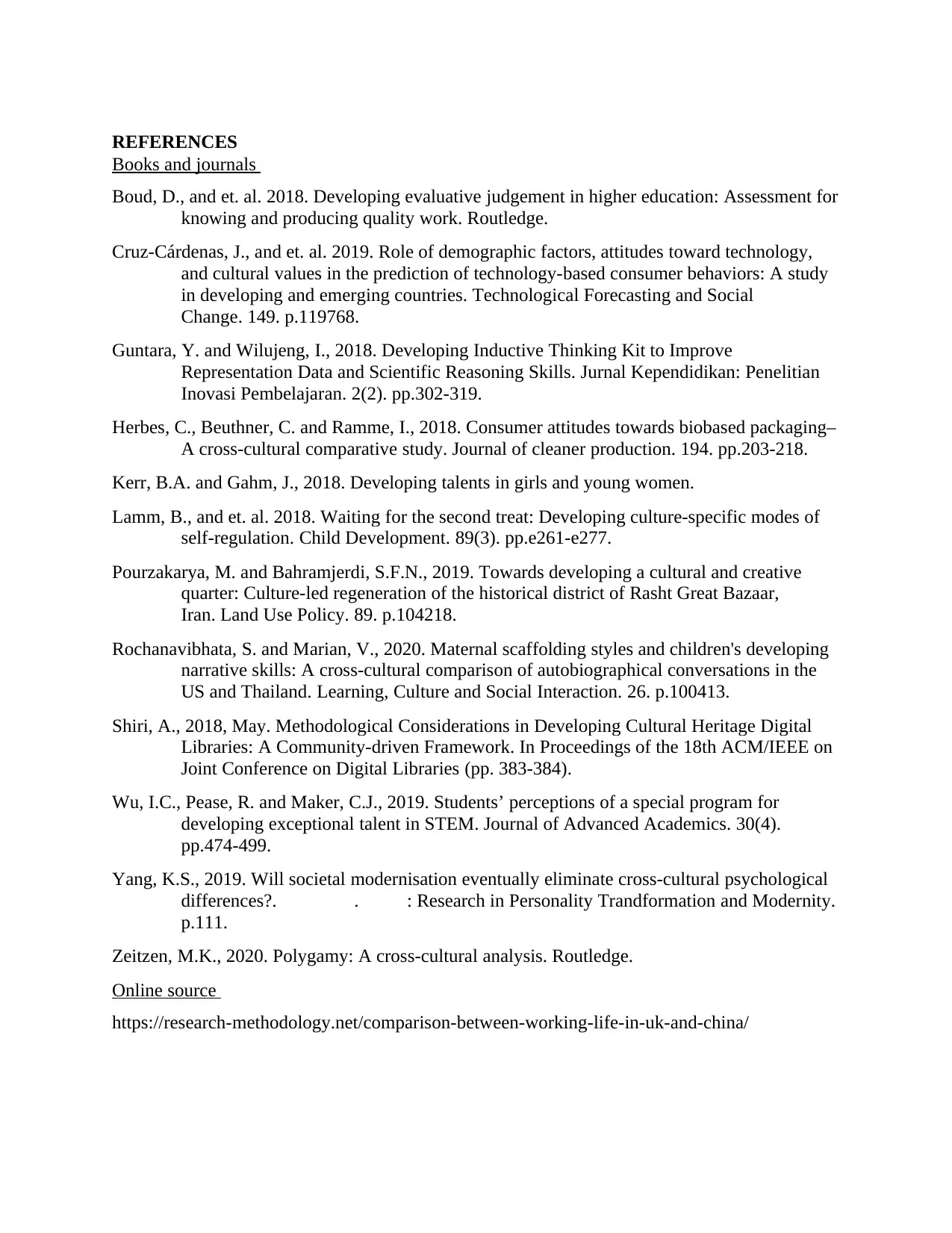
REFERENCES
Books and journals
Boud, D., and et. al. 2018. Developing evaluative judgement in higher education: Assessment for
knowing and producing quality work. Routledge.
Cruz-Cárdenas, J., and et. al. 2019. Role of demographic factors, attitudes toward technology,
and cultural values in the prediction of technology-based consumer behaviors: A study
in developing and emerging countries. Technological Forecasting and Social
Change. 149. p.119768.
Guntara, Y. and Wilujeng, I., 2018. Developing Inductive Thinking Kit to Improve
Representation Data and Scientific Reasoning Skills. Jurnal Kependidikan: Penelitian
Inovasi Pembelajaran. 2(2). pp.302-319.
Herbes, C., Beuthner, C. and Ramme, I., 2018. Consumer attitudes towards biobased packaging–
A cross-cultural comparative study. Journal of cleaner production. 194. pp.203-218.
Kerr, B.A. and Gahm, J., 2018. Developing talents in girls and young women.
Lamm, B., and et. al. 2018. Waiting for the second treat: Developing culture‐specific modes of
self‐regulation. Child Development. 89(3). pp.e261-e277.
Pourzakarya, M. and Bahramjerdi, S.F.N., 2019. Towards developing a cultural and creative
quarter: Culture-led regeneration of the historical district of Rasht Great Bazaar,
Iran. Land Use Policy. 89. p.104218.
Rochanavibhata, S. and Marian, V., 2020. Maternal scaffolding styles and children's developing
narrative skills: A cross-cultural comparison of autobiographical conversations in the
US and Thailand. Learning, Culture and Social Interaction. 26. p.100413.
Shiri, A., 2018, May. Methodological Considerations in Developing Cultural Heritage Digital
Libraries: A Community-driven Framework. In Proceedings of the 18th ACM/IEEE on
Joint Conference on Digital Libraries (pp. 383-384).
Wu, I.C., Pease, R. and Maker, C.J., 2019. Students’ perceptions of a special program for
developing exceptional talent in STEM. Journal of Advanced Academics. 30(4).
pp.474-499.
Yang, K.S., 2019. Will societal modernisation eventually eliminate cross-cultural psychological
differences?. 楊楊楊楊楊. 楊楊楊: Research in Personality Trandformation and Modernity.
p.111.
Zeitzen, M.K., 2020. Polygamy: A cross-cultural analysis. Routledge.
Online source
https://research-methodology.net/comparison-between-working-life-in-uk-and-china/
Books and journals
Boud, D., and et. al. 2018. Developing evaluative judgement in higher education: Assessment for
knowing and producing quality work. Routledge.
Cruz-Cárdenas, J., and et. al. 2019. Role of demographic factors, attitudes toward technology,
and cultural values in the prediction of technology-based consumer behaviors: A study
in developing and emerging countries. Technological Forecasting and Social
Change. 149. p.119768.
Guntara, Y. and Wilujeng, I., 2018. Developing Inductive Thinking Kit to Improve
Representation Data and Scientific Reasoning Skills. Jurnal Kependidikan: Penelitian
Inovasi Pembelajaran. 2(2). pp.302-319.
Herbes, C., Beuthner, C. and Ramme, I., 2018. Consumer attitudes towards biobased packaging–
A cross-cultural comparative study. Journal of cleaner production. 194. pp.203-218.
Kerr, B.A. and Gahm, J., 2018. Developing talents in girls and young women.
Lamm, B., and et. al. 2018. Waiting for the second treat: Developing culture‐specific modes of
self‐regulation. Child Development. 89(3). pp.e261-e277.
Pourzakarya, M. and Bahramjerdi, S.F.N., 2019. Towards developing a cultural and creative
quarter: Culture-led regeneration of the historical district of Rasht Great Bazaar,
Iran. Land Use Policy. 89. p.104218.
Rochanavibhata, S. and Marian, V., 2020. Maternal scaffolding styles and children's developing
narrative skills: A cross-cultural comparison of autobiographical conversations in the
US and Thailand. Learning, Culture and Social Interaction. 26. p.100413.
Shiri, A., 2018, May. Methodological Considerations in Developing Cultural Heritage Digital
Libraries: A Community-driven Framework. In Proceedings of the 18th ACM/IEEE on
Joint Conference on Digital Libraries (pp. 383-384).
Wu, I.C., Pease, R. and Maker, C.J., 2019. Students’ perceptions of a special program for
developing exceptional talent in STEM. Journal of Advanced Academics. 30(4).
pp.474-499.
Yang, K.S., 2019. Will societal modernisation eventually eliminate cross-cultural psychological
differences?. 楊楊楊楊楊. 楊楊楊: Research in Personality Trandformation and Modernity.
p.111.
Zeitzen, M.K., 2020. Polygamy: A cross-cultural analysis. Routledge.
Online source
https://research-methodology.net/comparison-between-working-life-in-uk-and-china/
⊘ This is a preview!⊘
Do you want full access?
Subscribe today to unlock all pages.

Trusted by 1+ million students worldwide
1 out of 9
Related Documents
Your All-in-One AI-Powered Toolkit for Academic Success.
+13062052269
info@desklib.com
Available 24*7 on WhatsApp / Email
![[object Object]](/_next/static/media/star-bottom.7253800d.svg)
Unlock your academic potential
Copyright © 2020–2025 A2Z Services. All Rights Reserved. Developed and managed by ZUCOL.




